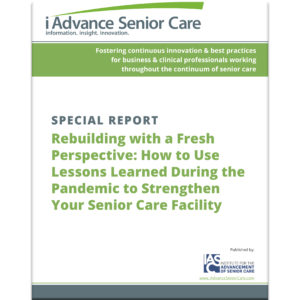Alleviating compassion fatigue before it drags down productivity
Long-term care employees know how to take care of others, but they don’t always know how to take care of themselves. As a result, they can end up feeling isolated, withdrawn, apathetic or even hostile to co-workers and patients. These feelings can lead to emotional outbursts, substance abuse and recurring nightmares.
Studies show that 25-50 percent of healthcare workers experience these symptoms. Left untreated, they can lead to clinical depression.
As LTC providers know, a disgruntled employee can spread misery throughout the organization and poison productivity in the workplace. Issues like these can result in absenteeism, accidents, inefficiency and higher turnover, according to a study conducted by the Indiana University School of Medicine and the Regenstrief Institute. Over time, these unaddressed problems can lead to medical, legal and insurance costs as well as workman’s compensation awards.
Job stress is estimated to cost $200-300 billion annually for American industry. When the job relies on a person’s ability to care for patients physically, the cost can be even greater. Guilt often delays recognition of the problem—and the necessity of doing something to solve it.
WHEN COMPASSION HURTS
Compassion can be a helpful emotion in a nursing home setting. It can contribute to job satisfaction and help the employee withstand the trauma of working in a difficult environment. The term “compassion satisfaction” refers to this special quality that comes from working in settings where compassion is needed.
Healthcare workers often go into the field because they have suffered trauma themselves and can relate to it in others. As a result, it is harder for them to separate themselves from other people’s pain. If employees don’t balance caring for themselves with caring for others, they can experience stress, burnout, or even compassion fatigue.
Burnout is common in today’s world. It generally comes from dissatisfaction with the job and develops over time, leading to apathy and exhaustion. Compassion fatigue, however, tends to happen much more quickly. It occurs not because of job dissatisfaction, but when caregivers experience trauma while witnessing a patient’s physical, emotional or even spiritual pain. Charles Figley, PhD, one of the founders of the traumatology field, called it “the cost of caring for others in emotional pain.”
While caregiver fatigue is a normal response to these difficult and demanding careers, becoming involved in a patient’s trauma is not.
Employees also can experience what is known as “counter-transference”—when an employee is reminded of a traumatic event in his or her own life because of similarities in the patient’s situation. When the employee begins to identify with the nursing home patient, it increases the risk of suffering via transference.
Secondary vicarious re-traumatization happens when identification with a patient begins to take hold of the employee’s perceptions. It can affect an employee’s tolerance of daily stress, reduce interest in daily activities, and lead to an avoidance of thoughts, feelings and even other people.
PROACTIVE STRESS MANAGEMENT
While it is not the facility administration’s role to monitor its employees’ private lives, the organization should be aware of the healthcare professionals who are most at risk. These include newer members to the field, people with a history of personal trauma, workers with large caseloads or longer hours, those who already have experienced burnout, those who have problems communicating, and those who do not have adequate personal support systems.
Among healthcare workers, people who can accept failure and do not feel responsible for poor outcomes handle job stress better. Studies have shown that there is a connection between the ability to roll with the punches and the ability to withstand the hardships of life—and the intensity of working in skilled nursing facilities.
Providers can start by acknowledging the problem among themselves and then with their employees. They need to lay the issue on the table so that a dialogue about it can begin—including the particular difficulties of working at nursing homes.
Workshops on compassion fatigue and self-care are especially helpful in this regard, since they bring the issue into the open. By offering training, providers show employees they are serious about creating a healthy environment for everyone. Providers need to understand that a compassion-fatigued staff is a compassion-fatigued organization.
LTC providers also need to institute policies and procedures that encourage employees to take care of themselves. Even simple things like allowing time off for emergencies, making sure employees take breaks and eat regular meals, and not demanding ongoing, unpaid overtime can change the tone of the workplace in subtle but dramatic ways.
Providers also can arrange employee recognition days with a continental breakfast, afternoon snacks or a masseuse giving shoulder rubs to show that they are serious about creating a culture of health and happiness. Promoting incentives like VIP parking spaces, gift certificates or an extra paid day off can make a huge difference.
For providers who already are running a 24-hour operation of three regular shifts, allowing job-sharing or greater flexibility in hours may be a viable option. Other ideas include workshops on communication skills, assertiveness training or time-management skills.
Corporate wellness programs also help, since many agree that such programs are a win-win in the long run. More than 80 percent of companies with 50 employees or more have health programs that include exercise, back care, stress management and smoking-cessation initiatives. Having a brown bag lunch with a guest speaker on health is an easy way to start such a program. Weekly support groups for weight management and tobacco cessation also can help.
For providers, there is a payoff. A meta-analysis of studies by Baicker, Cutler and Song found that medical costs dropped by $3.27 and absenteeism dropped by $2.37 for every dollar spent on such programs.
Employees who make time for themselves with activities that create happiness in their own lives become more excited about their job and find more satisfaction in it—and are more productive employees as a result.
Patricia Smith is the founder of the Compassion Fatigue Awareness Project. A recognized expert, she speaks nationwide on the issue and gives workshops and training sessions across the country. Her latest book, Compassion Satisfaction: 50 Steps to Healthy Caregiving will be available June 15. She can be reached at patricia@compassionfatigue.org.
Related Articles
Topics: Articles , Executive Leadership , Risk Management











